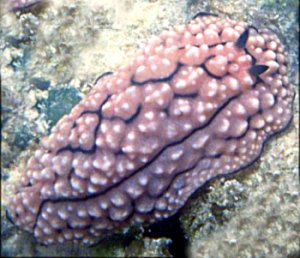
Phyllidiella hageni
Fahrner & Beck, 2000
Order: NUDIBRANCHIA
Suborder: DORIDINA
Superfamily: EUDORIDOIDEA
Family: Phyllidiidae
DISTRIBUTION
Currently known from Lombok, Indonesia only.
PHOTO
Gili Terawangan, Lombok, Indonesia, 35 mm specimen, 10 m depth, 12 September 1994, on
coral rubble.
This species is characterized by a pink background coloration and a variable pattern of black lines on the dorsum. Two narrow, longitudinal, black lines run from the rhinophores to the posterior body end. These two lines are connected by a transverse line in the middle of the body in some specimens. Various short, irregular, black lines occur medially along the mantle margin that has a contrasting black edge. Numerous low and coalesced pink tubercles with white apices are evenly and densely scattered on the dorsum. The rhinophores are bicoloured, pink basally and black apically, each clavus possesses 19 lamellae. Ventrally, P. hageni is entirely pale pink to pale grey. The separate, conical and highly diverging oral tentacles are pale pink in colour with black rounded tips.
References:
• Fahrner, A. & Beck, L.A. (2000) Identification key to the Indo-Pacific species of the nudibranch family Phyllidiidae Rafinesque 1814, including the description of two new species (Gastropoda: Opisthobranchia). Archiv für Molluskenkunde, 128: 189-211.
Fahrner, A. & Beck, L.A., 2000 (August 13) Phyllidiella hageni Fahrner & Beck, 2000 . [In] Sea Slug Forum. Australian Museum, Sydney. Available from http://www.seaslugforum.net/find/phylhage
Related messages
Phyllidiella hageni from SE Sulawesi, Indonesia [2]
May 21, 2007
From: Lindsay Warren
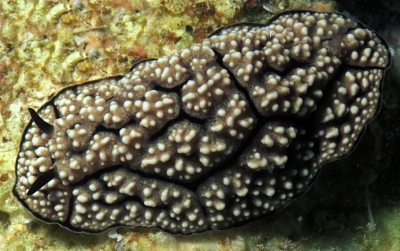
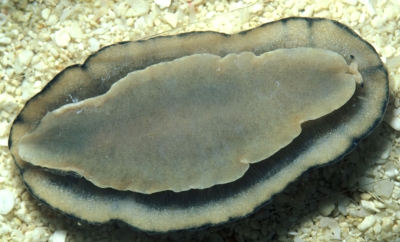
Dear Bill
Here are the details and additional photos of the second specimen (OS1000) of Phyllidiella hageni which was found by Jennifer Dean in the Tukang Besi Archipelago, SE Sulawesi in 2000 [see message #19196 for first specimen]. This specimen is preserved and held by the Museum Bogoriense, Cibinong, Java, Indonesia (Reg No: MZB.Gst.11.893).
One of the notes made with this specimen is that the chemicals it released "smelled like child sick" and was pretty potent from what I remember - most unpleasant.
Locality: 'Double Spur', Pulau Kaledupa, Tukang Besi Archipelago, 12 m, SE Sulawesi, Indonesia, Tropical Western Pacific, 24 August 2000, Steep slope to sheer drop off, reef in excellent condition. Length: 50 mm. Photographer: Lindsay Warren.
All the best
Lindsay
lwarren@datonomy.co.uk
Warren, L.C.R., 2007 (May 21) Phyllidiella hageni from SE Sulawesi, Indonesia [2]. [Message in] Sea Slug Forum. Australian Museum, Sydney. Available from http://www.seaslugforum.net/find/19197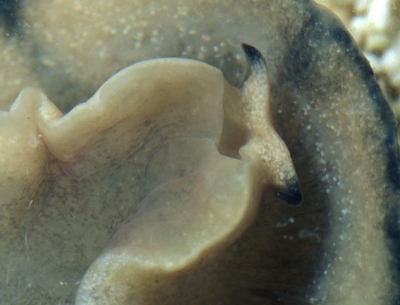
Dear Lindsay,
Thanks for these excellent shots of the oral tentacles. Unfortunately the oral tentacles of P. pustulosa are very similar in shape and colour so in this case they can't help us.
It is interesting to hear of the potent smell of the chemicals released by the skin glands of this species. I think they are probably the very isonitriles which have been isolated from some phyllidiid species. I think I have mentioned elsewhere walking into a lab one morning to find the room filled with an acrid smell which soon had my eyes watering. It came from a pair of Phyllidia varicosa in an aquarium who had killed all life in their tank by exuding these sponge metabolites from their glands. That is why I don't recommend them as aquarium 'pets'.
Best wishes,
Bill Rudman
Phyllidiella hageni from SE Sulawesi, Indonesia
May 21, 2007
From: Lindsay Warren
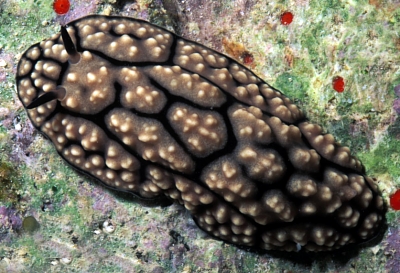
Dear Bill
I have been meaning to send the attached shots to you for some time and have been spurred on by another specimen from Fiji which I will send in a separate message [#19209 ] (although I am not entirely convinced it is the same species). Two specimens of Phyllidiella hageni were found in the Tukang Besi Archipelago, SE Sulawesi in 2000.
Photos and details of the first specimen I found (OS956) are attached here along with one shot of the anal papilla of OS1000 (details in separate message [#19197 ]). Unfortunately I didn't take any ventral shots of the first one but did make the following notes:
"Oral tentacles white, triangular, hyponotum white, foot pale grey and 'speckled' in centre, white towards edges."
Underwater it appeared to be an overall pale green/grey but natural light showed it to be pink. Other features noted include long slender rhinophores with black tip and posterior and pale translucent pink anterior and base. Pocket - pale translucent pink with tubercle behind it. Thin black mantle margin, anal papilla light pink and long.
Locality: 'Pak Kasim's Reef", Pulau Hoga, Tukang Besi Archipelago, 16 ft / 5 m, SE Sulawesi, Indonesia, Tropical Western Pacific, 27 June 2000, 16:05, Steep slope drop-off area on edge of main body of the island. Length: 43 mm. Photographer: Lindsay Warren.
This specimen in the upper photos is preserved and held by the Museum Bogoriense, Cibinong, Java, Indonesia (Reg No: MZB.Gst.11.908).
Lindsay Warren
lwarren@datonomy.co.uk
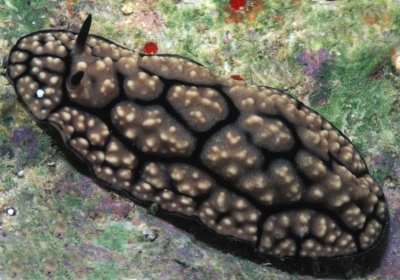
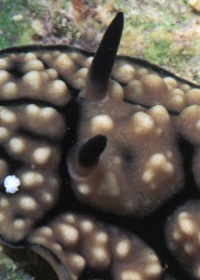

Dear Lindsay,
Thanks for these photos and the detailed notes. I am not entirely convinced I can tell the difference between P. hageni and P. pustulosa apart from the lack of any pink on the rhinophores of the latter, but if they are distinct, these animals from Pulau Hoga seem to fit the original description quite well.
The photo of the anal papillae is an interesting illustration of one of the main external characteristics of phyllidiids, and that is the loss of the dorsal gills associated with the anus.
Best wishes,
Bill Rudman
